"Mouse fuss" in infrared light: the introduction of nanoparticles into the subretinal region of the mouse eye

The world around us is full of information in various forms of its manifestation. It does not matter where you are: indoors or outdoors, in the city or in the middle of the field, in the tropics or in the snowy tundra. Always and everywhere your brain receives some kind of information. By itself, this body, if exaggerated, is useless in the matter of informing you about the environment. To help him, we have sensory organs (eyes, ears, tongue, nose and skin). However, far from all the information we are able to perceive, in particular infrared radiation, which is not visible to our eyes. At least it was before. Today we will meet with you a study in which an ordinary mouse was endowed with the ability to see infrared radiation from the near field through nanotechnology. How scientists have achieved this, how did the mouse feel after “improvement” and what are the prospects of this discovery for humans? We will look for answers to these and other questions in the report of the research group. Go.
Study basis
Vision in humans is not the best, but not the worst, among the inhabitants of planet Earth. It would be more correct to say that it has certain limitations. We are able to perceive "visible light", that is, radiation in the range from 400 to 700 nm. But infrared radiation of the near field (hereinafter NIR) is located above the upper limit of 700 nm.
If you dig a little deeper, then the problem is the structure of the eyes of mammals, that is, you and me. There are photoreceptors in the eye - photosensitive sensory neurons of the retina. Inside the cells there are opsin * and rhodopsin * , which play one of the most important roles in the perception of light, that is, in vision.
Opsins * are receptors associated with G-proteins located in photosensitive cells of the retina.
Rhodopsin * is a protein, the main visual pigment contained in the rods of the retina.This whole group of receptors is aimed at capturing light, that is, photons. But with NIR radiation, everything is much more complicated. In the case of NIR, photons have lower energy. Therefore, opsins must have a lower energy barrier in order to perceive such photons. Otherwise, there is only strong thermal noise. In other words, mammalian photoreceptors are simply physically unable to “capture” light radiation above 700 nm, in particular NIR radiation.
But you and I know that true physiological restrictions cannot stop true scientists. The problem with photoreceptors can be solved by providing them with assistants in the form of nanoparticles, which will perform those functions that are inaccessible to natural cells (organs, systems, etc.). This is what scientists did in their study. They developed special nanoparticles with a built-in autonomous source of light radiation, which can expand the range of the visual spectrum of a mammal (in this case, mice). Scientists explain that pbUCNP (retinal photoreceptorbinding upconversion nanoparticles) nanoparticles are a kind of energy converters. They convert near-infrared radiation into shorter wavelengths of visible light.
“Modification” of the mouse eye was carried out by subretinal injection (under the retina) of nanoparticles diluted in sodium phosphate buffer. The use of electroretinography * and data of visual evoked potentials * from the visual cortex of the mouse brain helped to establish the fact that the retina and the visual cortex were quite active when exposed to an external stimulus in the form of infrared radiation. Simply put, a mouse with embedded pbUCNP nanoparticles reacted to NIR radiation.
Evoked potential * - the electrical reaction of organs to an external stimulus.
Electroretinography * - the study of the state of the retina through the registration of biopotentials arising from light irritation.Behavioral tests were also conducted that also confirmed the above statement. In addition, scientists tested the biocompatibility of nanoparticles and the mouse organism, which showed only minor side effects. We will talk about the results of tests, tests and data analysis a little later, but for now we should familiarize ourselves with what these amazing nanoparticles consist of.
PbUCNP structure
The main objective of the nanoparticles was the conversion of infrared light (more than 700 nm) into visible. Considering that the human eye is most sensitive to visible light with a wavelength of 550 nm, the so-called conversion (or up-conversion) nanoparticles of UCNP ( 1A and 1B ) were created.
If we talk about photons, then up-conversion is the process of converting several photons with lower energy, i.e. with a large wavelength, into one photon with a higher energy, i.e. with a short wavelength. And this is exactly what is needed, given the properties of the photoreceptors of the eyes of mammals.
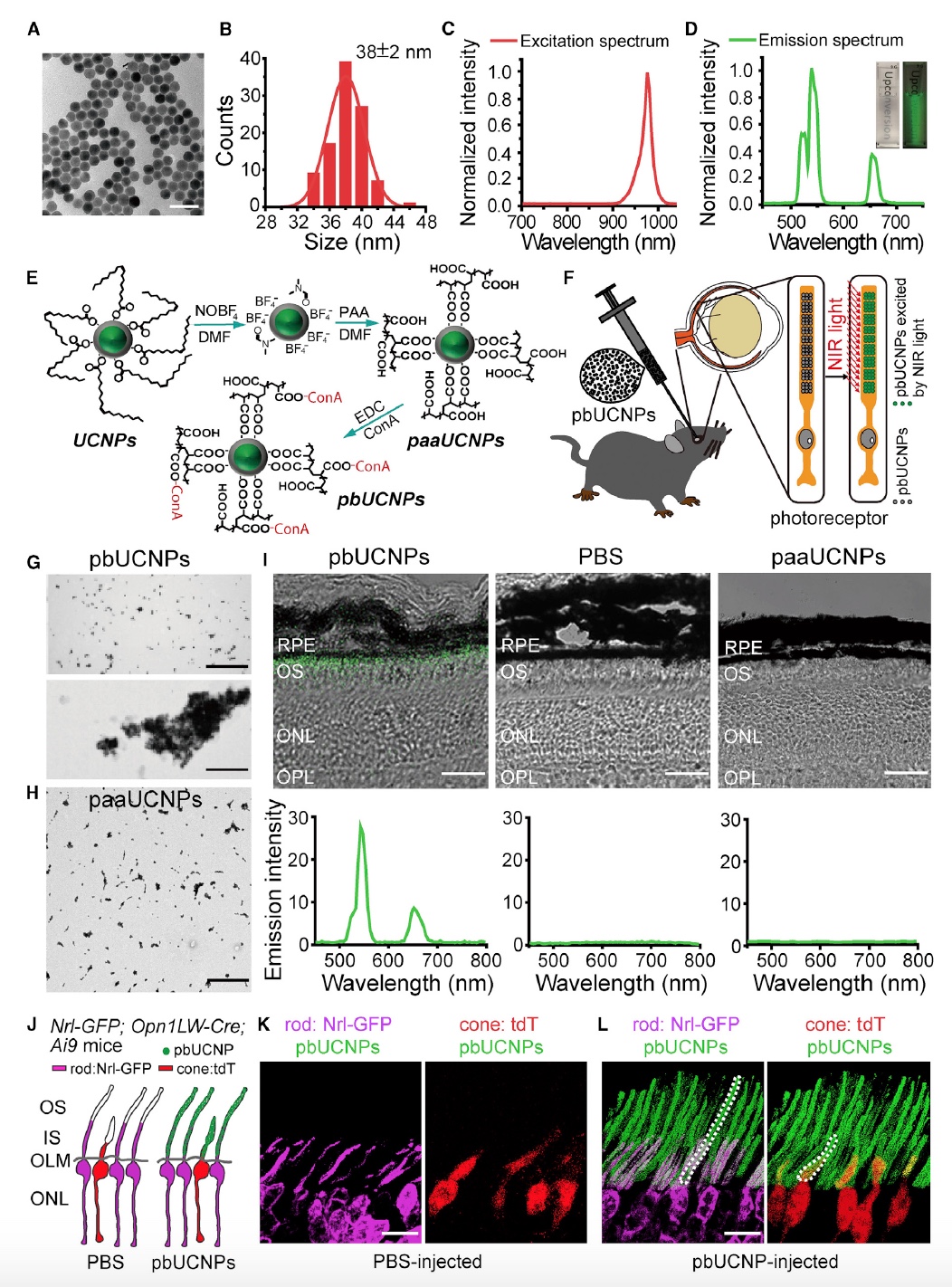
Image No. 1
These nanoparticles showed a peak in the excitation spectrum at 980 nm and a peak in radiation at 535 nm when exposed to light at 980 nm ( 1C and1D ).
To obtain water-soluble nanoparticles, scientists applied the protein concanavalin A (ConA) to the surface of paaUCNP particles, i.e. coated with polyacrylic acid ( 1E ). The use of ConA is justified by the fact that this protein binds perfectly to sugar residues and derivatives of the outer segment of the photoreceptor, resulting in glycosidic bonds * .
Glycoside bond * is a covalent bond between a sugar molecule and another molecule.It was necessary to verify the success of ConA implementation on the surface of UCNP. For this, scientists added b-cyclodextrin to the solution with pbUCNP, which has the same glucose unit as the outer segment of the photoreceptor. As a result of this, ConAb-cyclodextrin aggregation (association) took place (TEM image on image 1G ).
Therefore, such observations confirm that pbUCNP can successfully attach to the surface of mouse photoreceptors.
In the 1H TEM image, it can be seen that pbUCNPs retain their monodispersity when b-cyclodextrin is added, all because the ConA protein is absent in this combination. The introduction of such pbUCNP into the subretinal region of the mouse eye ( 1F) led to the fact that the nanoparticles bound to each other, forming a close relationship with both the inner and outer portions of cones and rods ( 1J , 1K and 1L ). Thus, a layer of nanoparticles with a characteristic up-conversion spectrum was formed (image on the left on 1I ).
If paaUCNP particles were introduced into the subretinal region of the mouse eye, then they formed very fragile bonds, so they could be easily removed from the photoreceptors (right image on 1I ).
The biocompatibility check did not show any serious abnormalities. For testing, a simple solution of sodium phosphate buffer (without nanoparticles) was also injected into the subretinal region of the eye of the mouse — no difference was found. Those side effects that were detected were associated with the subretinal injection itself and completely disappeared within 2 weeks after the procedure.
Checking the integrity of the retina and a healthy number of photoreceptors showed that even with the introduction of 50 mg of pbUCNP in each eye, no negative changes were observed. That is, the structure of the layers of the retina does not degrade (this can be seen in images 2A and 2B ).
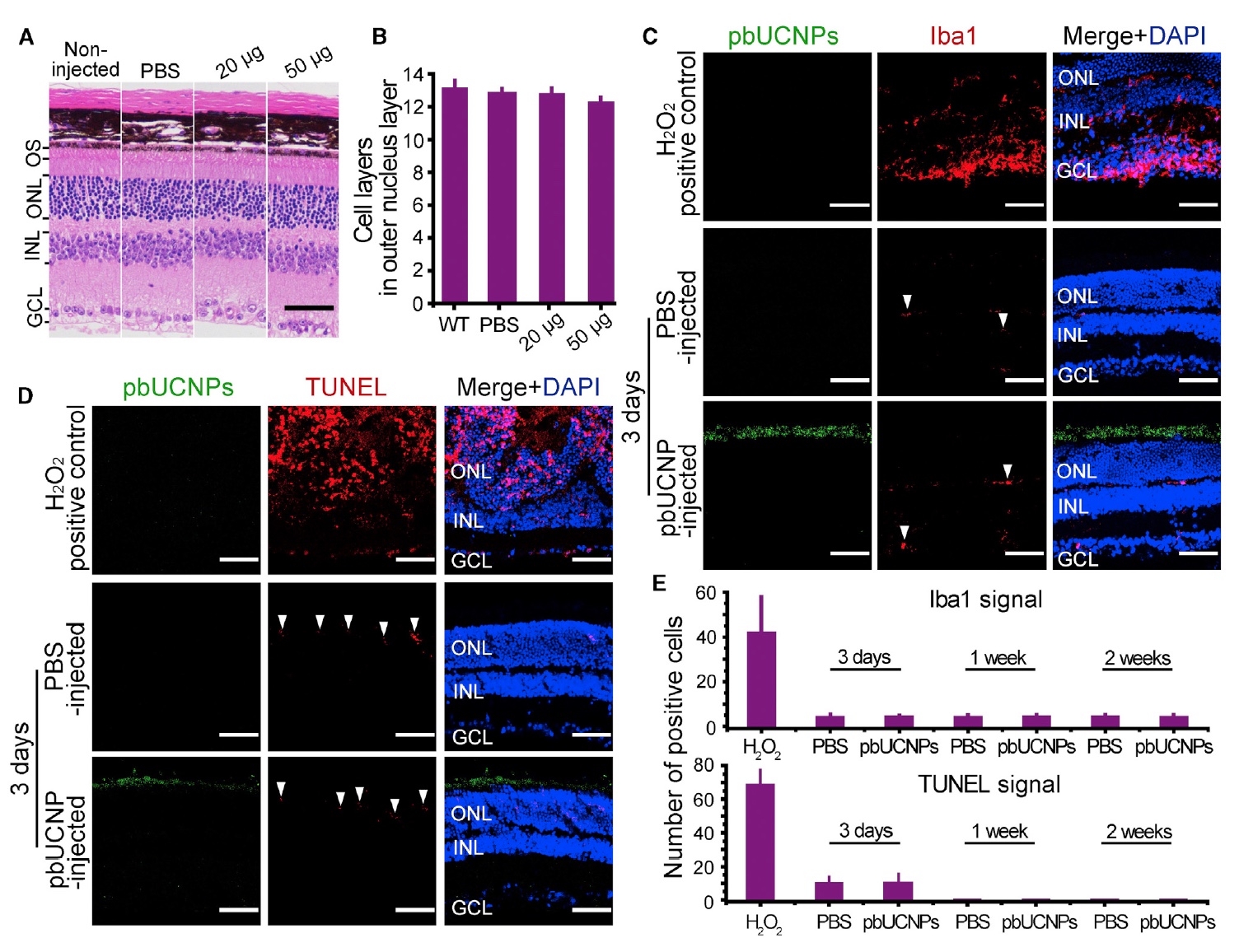
Image No. 2
Scientists also decided to check for inflammatory processes in the rat's retina using the Iba1 microglia marker. The analysis showed slight inflammation of the retina at the 1st, 2nd, 4th and 10th week after injection of pbUCNP ( 2C and 2E ).
In addition, apoptosis (decay) of retinal cells after injection was tested by labeling with terminal deoxynucleotidyl transferase (TUNEL). TUNEL signals were detected only 3 days after injection of both pbUCNP and pure sodium phosphate buffer ( 2D ). On the 1st, 2nd, 4th and 10th week after the injection, no TUNEL signs were detected ( 2E ).
Summing up the results of the above analyzes, the scientists came to the obvious conclusion - pbUCNP does not harm the body of the test person (mouse), except for certain side effects caused solely by the injection procedure into the subretinal region of the eye.
Now that we know what pbUCNP is and how it affects the health of experimental mice, we can proceed to consider the results of practical tests of the operability of pbUCNP nanoparticles.
Research results
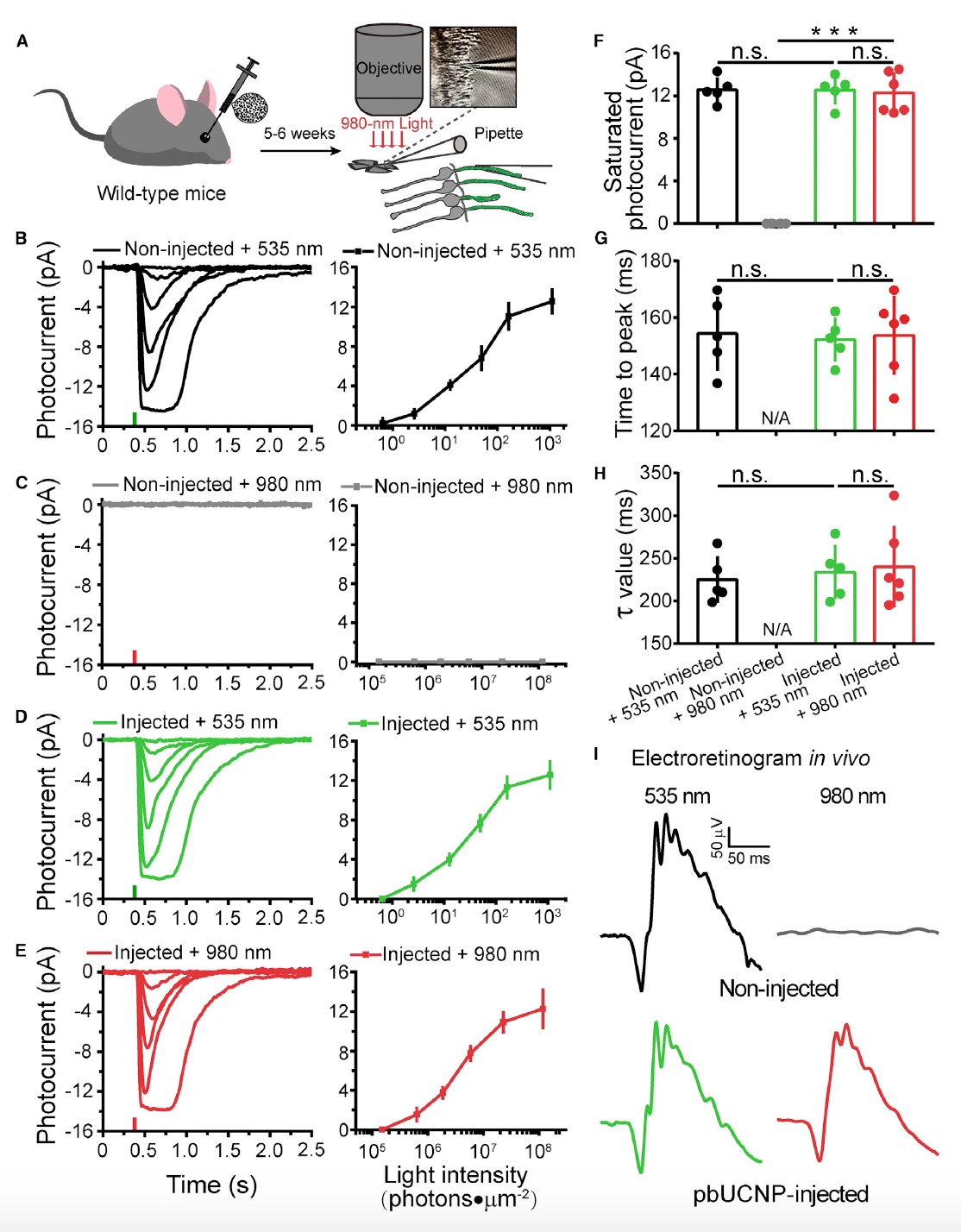
Image No. 3
To test the reaction of photoreceptors to infrared radiation, samples of rods from the retina were taken in a mouse with an injection of nanoparticles and in a mouse without it ( 3A ).
The sticks of mice injected with pbUCNP showed a normal photocurrent caused by visible light at 535 nm, in contrast to mice without injection (without injection - 3B and with injection - 3D ).
When exposed to a light flash of 980 nm, a response was obtained only from the rods of mice with pbUCNP ( 3E ), the rods of ordinary mice did not react at all ( 3C ). It is also worth noting the strong similarity between the amplitude and kinetics of the photocurrent in the rods of mice with pbUCNP when exposed to light of 535 nm and 980 nm ( 3F, 3G and 3H ). And the ratio of time and peaks suggests that there was no delay in the activation of the rods when exposed to infrared radiation. It was also revealed that the sticks (after injection) quickly adapt to infrared light, as is usually the case with visible light.
The electroretinogram (ERG) of mice with and without injection also confirmed a reaction to infrared radiation at 980 nm. Moreover, the ERG results of mice with pbUCNP strongly resembled the results when exposed to visible light (535 nm). The control group of mice (without nanoparticles) had no reactions.
In addition, scientists conducted a test with mice that did not have sticks. This test showed activation of cones by radiation at 980 nm by exposure to pbUCNP nanoparticles.
After conducting laboratory tests, scientists moved on to testing in practice, so to speak. That is, they decided to personally observe the behavior of mice with and without injection in special conditions.
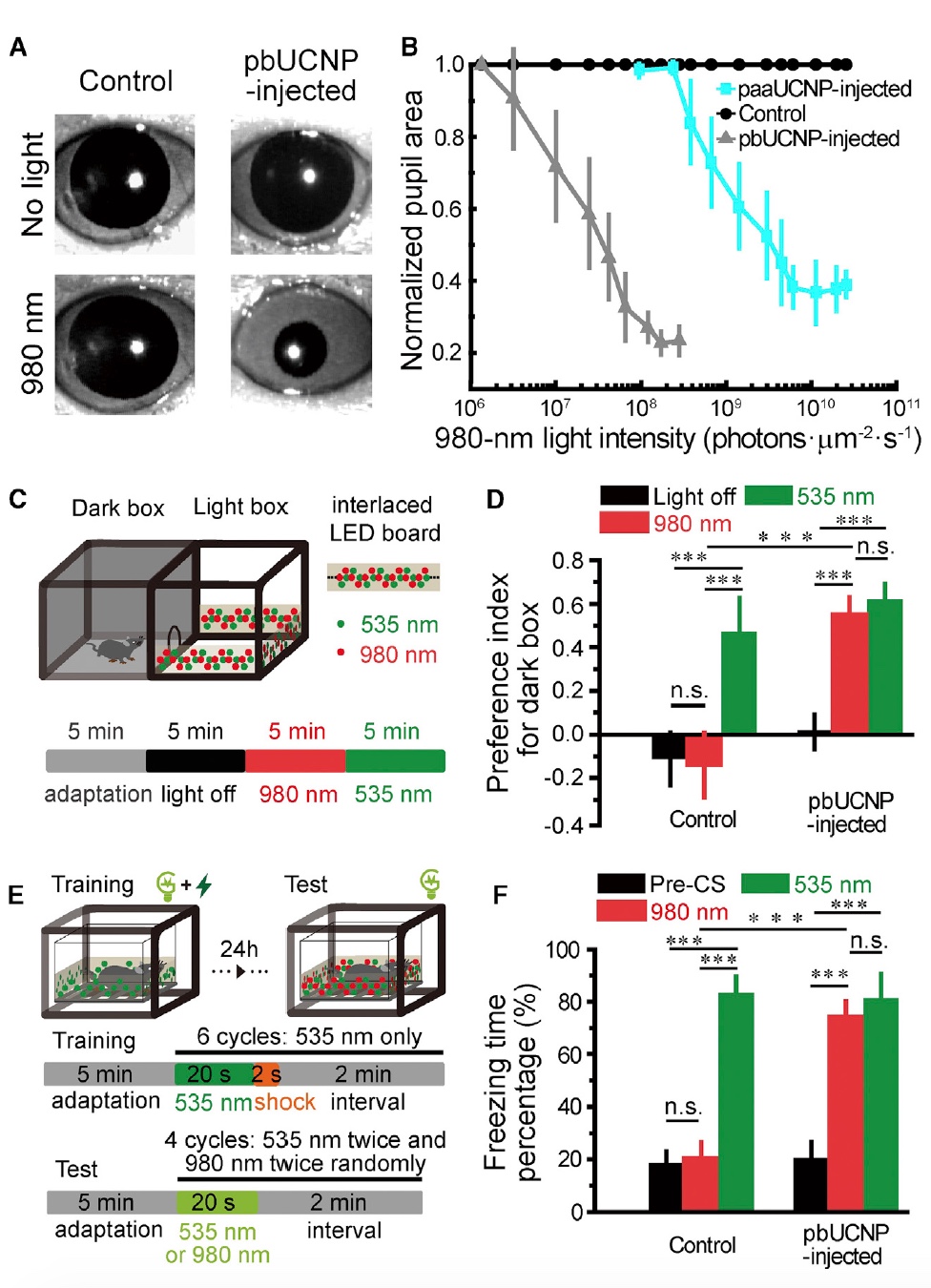
Image No. 4
For the practical experiment, two boxes were used: dark and illuminated by radiation in the visible and infrared ranges ( 4C and 4D ). The second version of the experiment is based on the relationship of the light stimulus and the resulting sense of fear ( 4E and 4F ). And now in more detail about each of the experiments.
In the first test with a dark and dark box lit by visible light, the mouse naturally preferred to be in the dark. Visible light was replaced by LED with a wavelength of 980 nm. In this version, mice with an injection of nanoparticles continued to choose a dark box rather than a light one, following their innate instincts, so to speak. But the control group of mice (without injection) did not see any difference between the two boxes (dark and with a light of 980 nm), since they literally did not perceive infrared radiation.
The second experiment was related to the study of even more deliberate actions of mice. At the preparation stage, mice from both groups were trained in the fact that after a 20-second light emission of 535 nm (visible), a two-second insignificant electric shock will follow ( 4Е) In response to such an irritant, a completely natural response in mice - numbness * should follow .
Numbness reaction * - in some species of animals, which are usually prey, there is a protective mechanism (so to speak, the last chance). If the predator has already attacked them, they can “pretend to be dead” (numb), thereby confusing the attacker and, having caught the right moment, escape.During the actual testing phase, light emission was applied at both 535 nm and 980 nm. As a result, mice injected with pbUCNP exhibited a numb reaction in both types of light exposure, as they expected an electric shock. But mice without nanoparticles did not react at all to infrared radiation. And this suggests that they did not perceive it during preparation and, therefore, could not connect the invisible radiation for them with a shock. The control group of mice had a response only to light in the visible range. Figure 4F shows a comparison of the results of this test in a control group of mice and injection mice.
How mice react in case of danger (numb, hide or shaking tail aggressively).
These practical tests confirmed the fact that mice with pbUCNP perceive infrared radiation, but can they really see in this range, in the truest sense of the word? In order to get an answer to this question, scientists conducted another test - measuring VEP, i.e. visual evoked potentials ( 5A ). For this, electrodes were installed in six areas of the visual cortex of the mouse brain (No. 1, 2, 3, and 5 in the monocular regions and No. 6 in the binocular regions).
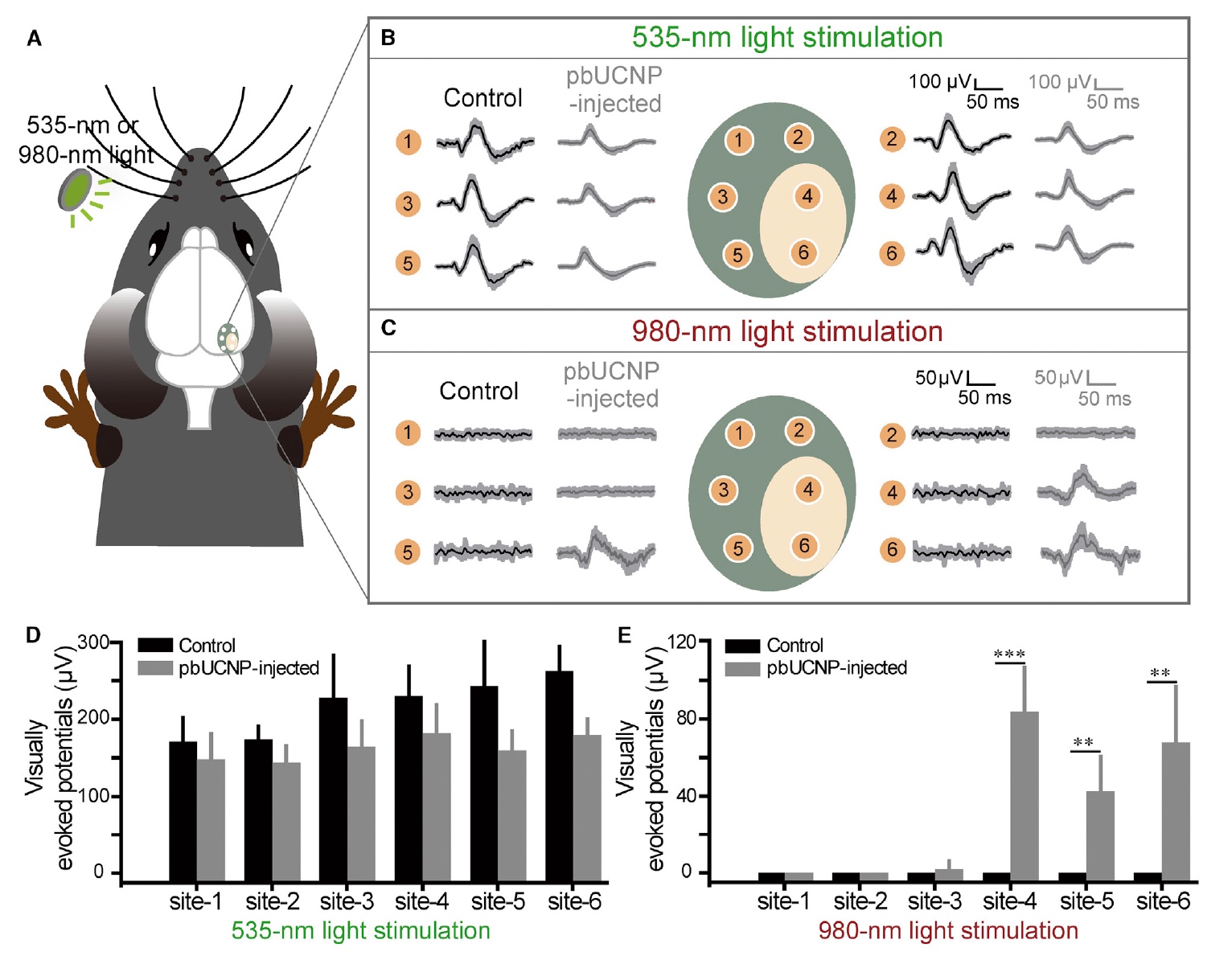
Image No. 5
When the eyes were exposed to visible light (535 nm), a reaction was observed in all areas of the visual cortex of all mice (with and without nanoparticles), which is quite expected ( 5B and 5D) But under the light at 980 nm, the mice were divided into two groups, as in previous tests. VEP was detected in injection mice in binocular areas of the visual cortex ( 5C and 5E ). No VEP was detected in the control group. It should be noted that the manifestation of VEP in the binocular areas is consistent with the injection site (temporal side).
This "mouse fuss" is not over. The next test again was a more practical test with a water labyrinth in the form of the letter “Y” ( 6A ), according to which pbUCNP mice should be guided by infrared radiation.
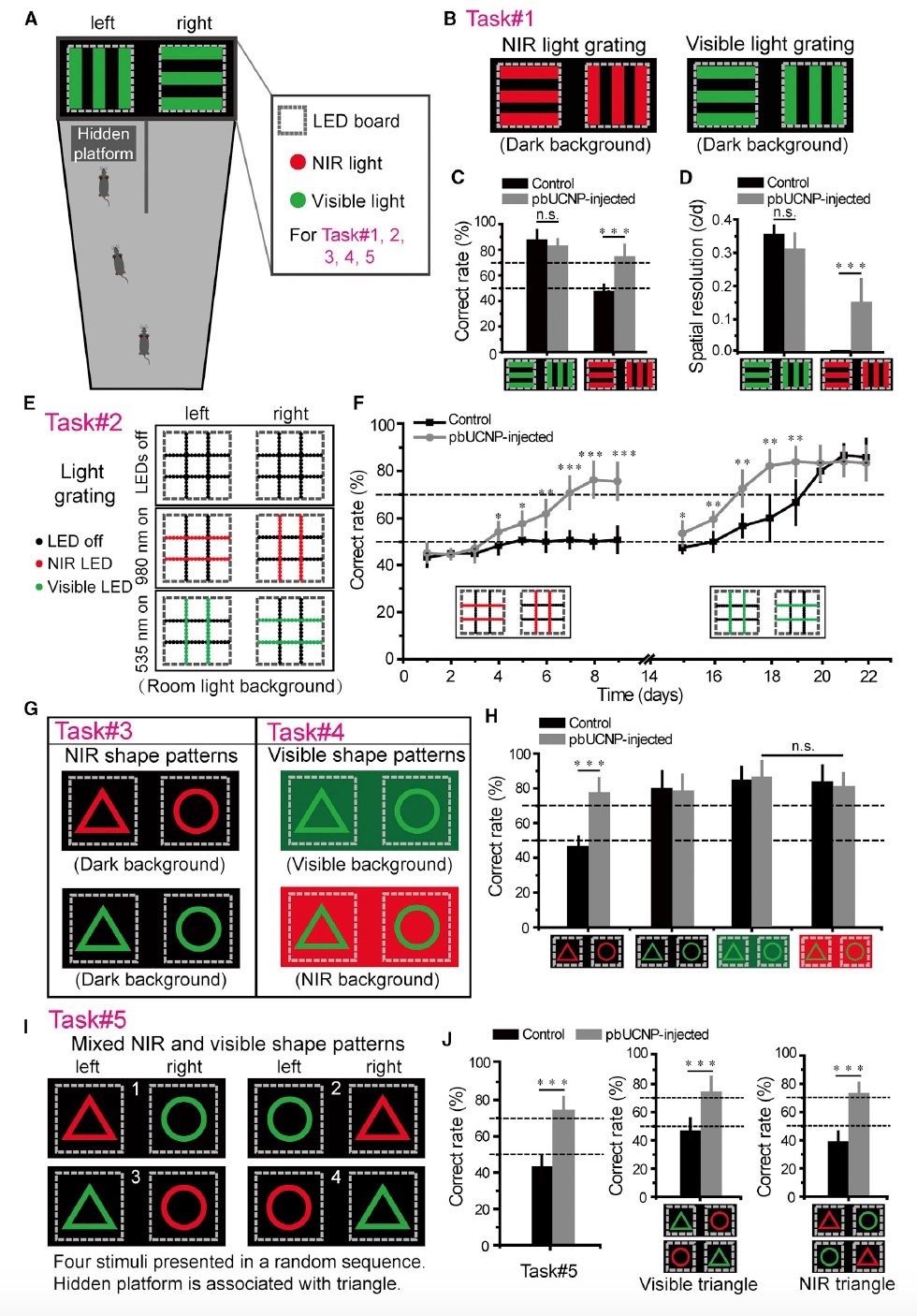
Image No. 6
During preparation, the mice were trained to find a hidden platform that was connected to one of two routes through the maze. In total, scientists made 5 test versions with different visual stimuli and light radiation.
In the first version there were light gratings ( 6B ), the position of the bands on which indicated the direction of movement. Mice with nanoparticles successfully learned to distinguish between the orientation of the bands (vertical or horizontal) and saw them perfectly when exposed to light radiation at 980 nm. The control group chose the platforms in random order, that is, could not distinguish them from each other due to the inability to see in the infrared spectrum ( 6C ). In the test where visible light was used (as during training), both groups of mice successfully completed the task.
Measurement of the wave number (spatial frequency) showed that in mice with injection this is 0.31 ± 0.04 in visible light. In mice from the control group, this indicator is 0.35 ± 0.02, that is, there are no special differences between the two groups of subjects. Therefore, the introduction of nanoparticles into the retina did not affect the way mice perceive visible light. In the case of infrared radiation in mice with pbUCNP, the above indicator was 0.14 ± 0.06. Scientists attribute such a decrease in spatial frequency to isotropic radiation and scattering of visible light from nanoparticles ( 6D ) excited by infrared light .
In the second version of the test, scientists decided to check whether radiation in the visible range interferes with the perception of infrared radiation of photons. 2 plates were made with LED arrays of visible (535 nm) and infrared (980 nm) radiation, which are perpendicular to each other. When all the LEDs were off, both plates looked identical against the background of visible light ( 6E ).
During preparation, illumination (visible light, 196 lux) and only 980 nm LEDs were turned on in the test chamber. During the actual test, only the injection mice were able to successfully recognize the plates ( 6F) This suggests that their perception of infrared radiation did not deteriorate in any way due to the background radiation of visible light. In the case when only 535 nm LEDs were turned on, both groups of mice showed good results, as expected.
The next test was recognition of triangles and circles ( 6G ). Mice with pbUCNP successfully distinguished figures in visible and infrared light when the test chamber was unlit, that is, in the dark ( 6H ). The control group could detect only figures from visible light.
After that, another variable was added to the task - background light, but not visible, as before, but infrared. The pbUCNP mice still successfully distinguished between infrared / visible light patterns under background infrared radiation.
In the final test, the scientists decided to find out if the injection mice can see the figures in the infrared and visible range at the same time. In this test, there was a water maze with platforms on which a circle and a triangle were depicted simultaneously. During preparation, only triangles in visible light were active. But during testing, there were triangles and circles (980 nm) in a random sequence (6I). As expected, pbUCNP mice were very distinguished by figures (6J). Verification of the results of this test in both groups of test mice confirmed that the injection mice made the choice of a particular platform not by chance, in contrast to the control group. Thus, it can be concluded that injection of pbUCNP allows mice to see objects in both the infrared and visible ranges simultaneously.
For a more detailed acquaintance with the nuances of the study, I strongly recommend that you look into the report of scientists and additional materials to it.
Epilogue
Such a study is excellent evidence that nanotechnology can be applied in very different directions. Of course, to say that their possibilities are endless is still very early, but every day we are getting more and more new ways to use nanotechnology. In this particular case, the use of nanoparticles to present mice with infrared vision is not only an interesting experiment, but also a confirmation of the unique capabilities of the introduced improvements in biological systems. Scientists themselves are not yet ready to make high-profile statements regarding the application of their development in medicine or in any other areas, however they will continue their research with the aim of improving the above-described nanoparticles and, possibly, endowing them with new properties.
Be that as it may, the widespread use of augmentation by a person to improve and change his body will not happen soon due to not only imperfect technologies, but also the many ethical questions that many public figures are already asking. Can a person be allowed to change his body? Where is the border of permissible augmentations? How will this affect the social-class stratification in society? Will this give rise to new conflicts in an already conflict world? The list of such questions can be continued, but no one has given clear answers to them yet (the games of the Deus Ex series do not count). Perhaps the principle of "time will tell" fits here perfectly.
And, of course, Friday offtopic:
Creative advertising with an unexpected plot twist :)
Thank you for your attention, remain curious and have a great weekend, guys.
Creative advertising with an unexpected plot twist :)
Thank you for your attention, remain curious and have a great weekend, guys.
Thank you for staying with us. Do you like our articles? Want to see more interesting materials? Support us by placing an order or recommending it to your friends, a 30% discount for Habr users on a unique analogue of entry-level servers that we invented for you: The whole truth about VPS (KVM) E5-2650 v4 (6 Cores) 10GB DDR4 240GB SSD 1Gbps from $ 20 or how to divide the server? (options are available with RAID1 and RAID10, up to 24 cores and up to 40GB DDR4).
VPS (KVM) E5-2650 v4 (6 Cores) 10GB DDR4 240GB SSD 1Gbps until the summer for free when paying for a period of six months, you can order here .
Dell R730xd 2 times cheaper? Only we have 2 x Intel Dodeca-Core Xeon E5-2650v4 128GB DDR4 6x480GB SSD 1Gbps 100 TV from $ 249in the Netherlands and the USA! Read about How to Build Infrastructure Bldg. class using Dell R730xd E5-2650 v4 servers costing 9,000 euros for a penny?
